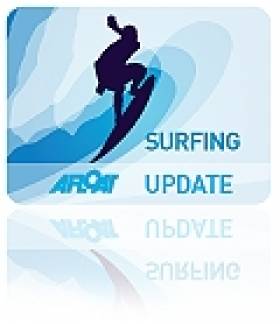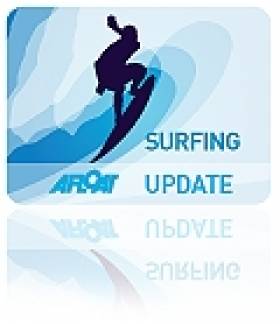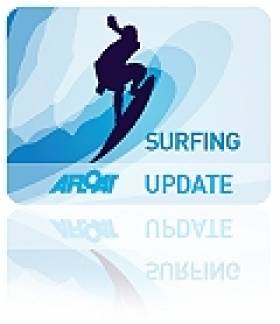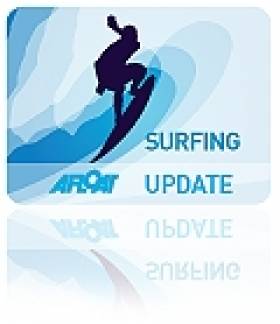Displaying items by tag: towin surfing
No Tow-In Surf Session for 2012
#SURFING - The second Billabong Tow-In Surf Session will not sadly run this year, following the end of the four-month waiting period yesterday.
Organisers decided to postpone the invitation-only event till next winter after conditions off Mullaghmore Head in Co Sligo failed to reach the minimum height requirement, as Magicseaweed reports.
“We’ve had a few swells that have come close,” said contest organiser Paul O’Kane of the Irish Surf Rescue Club. “However we set the standard incredibly high with the first event and were determined to only hold the event if the conditions were as good as that, if not better.”
Magicseaweed’s Ben Freeston concurred, saying that “the conditions needed for Mullaghmore to show it’s real face are so specific you might only see them a handful of times in the best years.
“This year we have had four or five swells that were big enough to be interesting, but not quite competition standard.”
The inaugural session was organised in an effort to dispel the myth that tow-in surfing, where surfers are towed by jetski to bigger offshore waves, is an irresponsible activity.
Last year's contest was also immortalised in an upcoming documentary from Mully Productions.
Young Bundoran Surfer Joins Northcore Stable
#SURFING - Irish surfer Conor Maguire is one of the four new waveriders from the UK and Ireland to become part of the Northcore stable. In the vid below Maguire is mentioned at 2 minutes 11 seconds.
The Bundoran resident joins Sandy Kerr of Tynemouth, England, Craig Burrows of south Wales and Jersey's Charlotte Bayliss on the team heading into 2012.
The young surfer is already making a name for himself on the heavy waves of Ireland's northwest coast like the Peak, and regularly paddling into the meanest of Ireland's slabs such as Rileys.
Maguire is also starting to charge in the big swells, learning the tow-in craft from some of Ireland's most experienced big wave crews, including Northcore ambassador Richie Fitzgerald.
A Northcore spokesperson said of the recent additions: "Between them there's a huge amount of experience, style and skill. All of the riders are representing the very best of surfing talent from their respective home locations and all have achieved respect and recognition on a national scale."
Cornish Surfer Rides Ireland's Record Biggest Wave
#SURFING - British surfer Jayce Robinson wasn't about to let the largest wave ever recorded off Ireland's shores go by without giving it a shot.
And as Sky News Online reports, he was captured doing exactly that on Tuesday afternoon.
The Cornish surfing pro told the website: "It was definitely the biggest barrell I've ever surfed.
"I was a little nervous but I didn't have time to think about it - it's almost like a car crash, you don't know what's happening."
Robinson rode the giant wave for 20 seconds before the lip crashed down and knocked him off his board.
His surfing partner Lyndon Wake, who towed him to the swell at Mullaghmore Head, said: "It's always a worst case scenario when your tow partner wipes out. Lucky he managed to come out the other side OK."
As previously reported on Afloat.ie, storm force winds off the coast of Donegal produced monster rollers of over 20 metres (over 60 feet) in height detected in Donegal Bay.
Mullaghmore Head will once again welcome the world's top big wave surfers for the second annual Tow-In Surf Session in the New Year.
Easkey Britton Talks About Her 'Whirlwind' Year in Surfing
#SURFING - Irish surfing ace Easkey Britton sat down with Cooler magazine to chat about her "whirlwind" last few months.
Britton, who comes from the highly regarded Donegal surfing dynasty, has spent much of this year jugging her studies towards a PhD in marine science with her training for the European Surfing Championships in her home county this past September.
"I don’t know how anyone survives their PhD without being able to jump in the sea and catch some waves," she says. "It clears my mind, renews my energy – the best ‘study breaks’ you can get. And I appreciate the sessions I have a lot more."
Now heading into winter, with the surf getting bigger every day, she's in training with tow partner Neil Britton for the second Tow-In Surf Session at Mullaghmore Head.
She says of last year's inaugural competition: "The conditions were unreal. Huge, clean, light winds, sunshine. A very rare combo. It was our first ever experience of something like that. The crowds covering the headland were massive, it felt like an amphitheater, or being a gladiator in the arena!"
Britton also talks about how her family has been a big inspiration to her both in her life and her accomplishments on the surfboard.
Cooler has more on the story HERE.
Irish-American Surfs 'World's Biggest Wave'
#SURFING - An Irish-American has ridden what's being called the biggest wave ever surfed in the world.
Garrett McNamara from Hawaii caught the 90-foot monster wave off the coast of Nazaré in Portugal earlier this month, The Irish Times reports.
"Everything was perfect, the weather, the waves," said Northern Irish surfer Al Mennie, who was tow-in surfing with McNamara and English rider Andrew Cotton when the giant swell arose at Praia do Norte.
The offshore area is noted for its deepwater canyon that channels massive swells from the Atlantic.
“As I rode this wave, it seemed pretty massive, but I couldn’t tell quite how big it was,” McNamara told surf forecast site Surfline.
“When I got to the bottom and turned and got around the wave and went to kick out, it landed on me and it felt like a ton of bricks.
"Probably one of the most powerful waves ever to land on me at the shoulder," he added. "It was pretty amazing.”
McNamara - whose family has Irish roots, according to Irish Central - is working with the Portuguese Hydrographic Institute as part of the ZON North Canyon Project, which aims to learn how waves reach such significant heights at Praia do Norte.
See video of the record-shattering wave ride below:
The Wait Begins for Second Tow-In Surf Session
#SURFING - The waiting period for the second Tow-In Surf Session at Mullaghmore Head is now under way.
The invite-only list of the world's top big wave surfers has until 1 March 2012 to try to best the monster waves ridden in last February's inaugural contest.
Irish pioneers Richie Fitzgerald, Peter Conroy and Glyn Ovens will be on call for the return event, which has also invited back open teams winners Benjamin Sanchis and Éric Rebière, according to Surfworld Bundoran.
Sanchis is also the 2011 Billabong XXL biggest wave award winner, and intends to defend his crown in Sligo.
“Mullaghmore is a spectacular wave, but you really need to be prepared to surf big waves there," he said.
The first Tow-in Surf Session - which was even immortalised in a documentary - was organised by the Irish Surf Rescue Club in part to dispel the myth that tow-in surfing, where surfers are towed by jetski to bigger offshore waves, is an irresponsible activity.
“Our team has put an enormous amount of training, both here and abroad, to ensure that the sport of tow surfing and this event can be as safe as possible," said organiser Paul O'Kane.
The latest news on the second Tow-In Surf Session will be made available on the Billabong website HERE.


































































